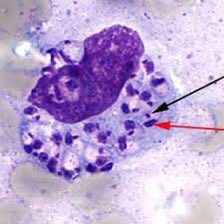Makindo Medical Notes"One small step for man, one large step for Makindo" |
|
|---|---|
| Download all this content in the Apps now Android App and Apple iPhone/Pad App | |
| MEDICAL DISCLAIMER: The contents are under continuing development and improvements and despite all efforts may contain errors of omission or fact. This is not to be used for the assessment, diagnosis, or management of patients. It should not be regarded as medical advice by healthcare workers or laypeople. It is for educational purposes only. Please adhere to your local protocols. Use the BNF for drug information. If you are unwell please seek urgent healthcare advice. If you do not accept this then please do not use the website. Makindo Ltd. |
Leishmaniasis (Cutanenous and Visceral)
-
| About | Anaesthetics and Critical Care | Anatomy | Biochemistry | Cardiology | Clinical Cases | CompSci | Crib | Dermatology | Differentials | Drugs | ENT | Electrocardiogram | Embryology | Emergency Medicine | Endocrinology | Ethics | Foundation Doctors | Gastroenterology | General Information | General Practice | Genetics | Geriatric Medicine | Guidelines | Haematology | Hepatology | Immunology | Infectious Diseases | Infographic | Investigations | Lists | Microbiology | Miscellaneous | Nephrology | Neuroanatomy | Neurology | Nutrition | OSCE | Obstetrics Gynaecology | Oncology | Ophthalmology | Oral Medicine and Dentistry | Paediatrics | Palliative | Pathology | Pharmacology | Physiology | Procedures | Psychiatry | Radiology | Respiratory | Resuscitation | Rheumatology | Statistics and Research | Stroke | Surgery | Toxicology | Trauma and Orthopaedics | Twitter | Urology
The risk of infection is highest from dusk to dawn, when sand flies are most active. Amphotericin B is now the treatment of choice due to rising resistance to pentavalent antimonials.
📖 About
- Three major forms: Cutaneous (CL), Mucocutaneous (MCL), and Visceral (VL).
- Spread by infected sand flies:
- Lutzomyia species in the New World.
- Phlebotomus species in the Old World.
- Protozoan parasites of the Leishmania family.
- Endemic in Central/South America, Africa, India, Middle East, Asia, Southern Europe, and the Mediterranean.
🧬 Mechanism of Infection
- Inoculated promastigotes are phagocytosed by macrophages.
- They transform into amastigotes, multiply by binary fission, and evade nitric oxide killing.
- Rupture of infected macrophages → spread to other cells in the reticuloendothelial system.
🦟 Transmission
- Vector: infected sand flies living in mud huts and rural dwellings.
- Peak biting activity: evening, twilight, and night.
- Sand fly bites are silent and painless; lesions may go unnoticed until ulcers appear weeks to months later.
- Lesions may cause scarring; mucosal disease can lead to nasal destruction.
- Regional lymphadenopathy or lymphangitis may accompany skin lesions.

🩺 Clinical Manifestations
- Cutaneous Leishmaniasis (CL)
- Geography: Mexico, Central/South America, Middle East, Asia, N. Africa, Southern Europe.
- Parasites multiply in dermal macrophages near inoculation site → nodules/ulcers on arms, legs, face, ears.
- Classic ulcer: painless, chronic, may be called the “Baghdad boil”.
- May be mistaken for leprosy.
- Diagnosis: slit skin smear from raised ulcer edge or nodule centre (shows amastigotes).
- Mucocutaneous Leishmaniasis (MCL)
- Mainly in South America.
- Causes destructive lesions of nose, nasopharynx, palate, uvula, larynx, and upper airways.
- Visceral Leishmaniasis (VL, “Kala-azar”)
- Most severe form; frequently fatal if untreated.
- Caused by L. donovani, L. infantum, L. chagasi.
- Incubation up to 2 years (usually 8 months).
- Dissemination via macrophages → reticuloendothelial system.
- Symptoms: prolonged fever, weight loss, massive splenomegaly > hepatomegaly, pancytopenia.
🔍 Investigations
- FBC: anaemia, leucopenia, thrombocytopenia; low albumin, raised globulins.
- Diagnosis:
- Amastigotes (Leishman-Donovan bodies) on bone marrow aspirate.
- Tissue scraping: amastigotes within macrophages.
- Splenic aspirate (if safe: INR normal, platelets >40) – very sensitive.
- Consider co-infections: TB, dysentery, pneumonia; advanced disease predisposes to cancrum oris.
- Note: treated patients may later develop Post-kala-azar dermal leishmaniasis (PKDL), remaining reservoirs of infection.
💊 Management
- Amphotericin B is the treatment of choice (liposomal form preferred where available).
- Miltefosine or paromomycin may be used as alternatives in some regions.
- Cutaneous lesions: may heal spontaneously but can require antimonials, amphotericin, or cryotherapy depending on severity.
- Supportive care: treat malnutrition, secondary infections, and anaemia.
🛡️ CDC Advice (Prevention)
- Stay in screened/air-conditioned rooms; avoid outdoor activities from dusk to dawn.
- Wear protective clothing (long sleeves, trousers, socks, tucked-in shirt).
- Apply insect repellents with DEET (30–35% for adults; ≤10% for children aged 2–6; avoid in <2 years).
- Spray clothes with permethrin-containing insecticides; reapply after washing.
- Spray rooms with insecticides; sand flies are highly susceptible.
- Use fine-mesh bed nets (≥18 holes per inch), ideally treated with permethrin.
🧾 Clinical Case Reports – Leishmaniasis
Case 1 – Cutaneous Leishmaniasis 🩹 A 28-year-old soldier returns from the Middle East with a slowly enlarging ulcer on his forearm. The lesion has a raised border and central crust but is painless. Skin biopsy shows amastigotes of Leishmania major. 👉 Diagnosis: Cutaneous leishmaniasis. 👉 Management: Local wound care and intralesional antimonials; spontaneous healing possible but scarring likely.
Case 2 – Visceral Leishmaniasis (Kala-azar) 🌙 A 6-year-old boy from rural India presents with fever, weight loss, massive splenomegaly, and pancytopenia. Bone marrow aspirate confirms Leishmania donovani. 👉 Diagnosis: Visceral leishmaniasis. 👉 Management: Liposomal amphotericin B, nutritional support, and monitoring for relapse.